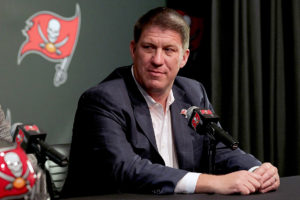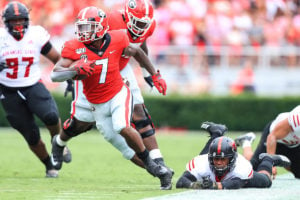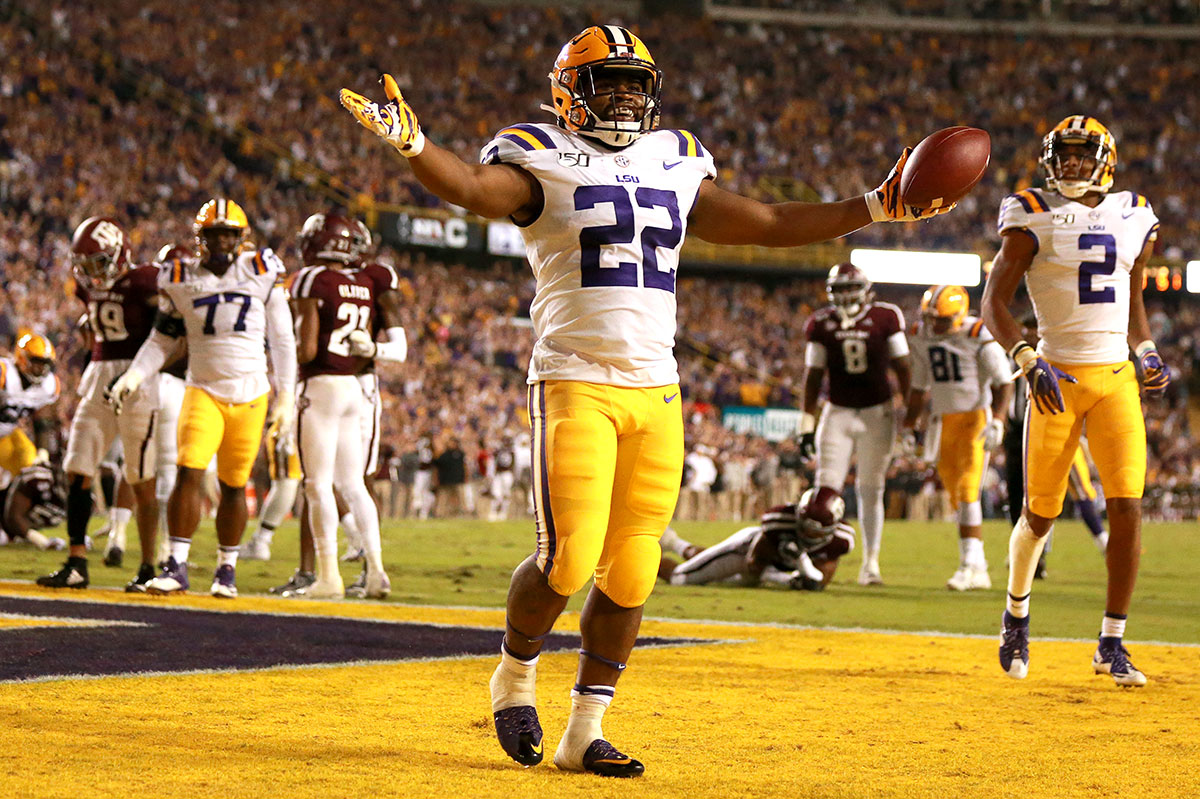FAB 2. Licht Needs To Draft The Right RB
Jason Licht has drafted a few positions exceptionally well since taking over as Tampa Bay’s general manager in 2014. Wide receiver is atop the list, having selected a pair of Pro Bowlers in Mike Evans (2014) and Chris Godwin (2017) along with a couple of contributors in Scotty Miller (2019) and Justin Watson (2018) that are expected to contend for bigger roles in 2020.
Licht has also done a fine job drafting linebackers, selecting a Pro Bowler in Kwon Alexander (2015) and a very promising prospect in starting inside linebacker Devin White (2019). His selection of Kendell Beckwith (2017) also showed promise until a serious ankle injury Beckwith suffered in an offseason car crash prematurely ended his NFL career after his rookie year.

Bucs GM Jason Licht – Photo by: Cliff Welch/PR
Licht drafted a pair of offensive linemen in Donovan Smith (2015) and Ali Marpet (2015) that have been signed to big second contracts, and an up-and-coming starter in Alex Cappa (2018).
There have been some positions where it’s been a toss-up, including cornerback, safety, tight end, and a few where Licht has really struggled, including defensive line and running back.
In fact, Licht’s track record for addressing the running back position has been just plain bad. Let’s go back to the beginning and examine the running back stable he’s built.
Licht inherited Doug Martin and made the difficult decision to re-sign him to a long-term contract in 2016 after Martin rushed for 1,400 yards and made the Pro Bowl in 2015, which was Dirk Koetter’s first season as offensive coordinator. When Licht fired Smith and promoted Koetter to head coach in 2016, he essentially had to re-sign Martin. It would have been criminal to rob Koetter of a Pro Bowl running back that helped him become Tampa Bay’s head coach.
Licht should have just given Martin the one-year franchise tag in hindsight, especially given Martin’s substance abuse issues, which were in-house at the time and not publicly known.
And Licht should have drafted better.
The first running back Licht drafted was Charles Sims in the third round in 2014, followed by the selection of two wasted draft picks on a pair of fullbacks in Joey Iosefa (2015) and Danny Vitale (2016) – neither of whom made the team. Sims was nothing more than a pass-catching third-down back and lasted just four years in the league.
The next running back Licht selected was Jeremy McNichols in the fifth round of the 2017 draft. That draft class was chock-full of running backs, including Leonard Fournette and Christian McCaffrey before the Bucs picked at No. 19, where Licht selected tight end O.J. Howard over running back Dalvin Cook, who fell to the second round.

Former Bucs RB Jeremy McNichols – Photo by: Getty Images
Other running backs the Bucs passed on include Joe Mixon, Alvin Kamara, Kareem Hunt, James Conner, Tarik Cohen, Brian Hill and Marlon Mack before Licht selected McNichols, who was drafted ahead of Aaron Jones. The 2017 draft was a goldmine of running backs, but Licht and Koetter waited too long and came up empty.
McNichols, a Boise State product that Koetter lobbied for partly because he coached at Boise State in the past and was an Idahoan, couldn’t grasp the playbook and didn’t even make the team. Peyton Barber, an undrafted free agent from 2016, would lead the Bucs in rushing in 2017 and ’18, even after Licht spent a second-round pick on Ronald Jones II in the 2018 draft. Jones had a horrific rookie season with 44 yards and one touchdown and a paltry 1.9-yard average.
Last year Jones showed some promise, beating out Barber for the starting job halfway through the season and finishing with 724 yards and six touchdowns while averaging 4.2 yards per carry. Licht and the Bucs have high hopes for Jones, but need to fortify the backfield with at least two other starting-caliber rushers for depth purposes.
Like the 2017 draft, the 2020 draft is loaded with quality running backs the Bucs could use from Wisconsin’s Jonathan Taylor, Georgia’s D’Andre Swift, LSU’s Clyde Edwards-Helaire and Ohio State’s J.K. Dobbins early to Florida State’s Cam Akers, Utah’s Zach Moss and Miami’s DeeJay Dallas in the middle rounds to Arizona State’s Eno Benjamin and Memphis’ Patrick Taylor, Jr. in the late rounds.
The key to success for Tampa Bay’s improved rushing attack in 2020 isn’t just to rely on Jones to continue to develop and ascend. It is also based on replacing Barber with a far better, more productive runner. And it’s based on upgrading the talent for the third-down back role.

Georgia RB D’Andre Swift – Photo by: Getty Images
That may mean Licht signing a cheap veteran after the draft – in addition to drafting a running back or two later this month. Licht needs to flood the position – just in case he drafts a running back that has an awful rookie season similar to that of Jones. The Bucs need to hedge their bets and also add a veteran running back like Freeman or Hyde to the mix.
Of course any team’s successful ground game isn’t just tied to the talent at running back. The blocking up front is just as key. Tampa Bay’s offensive line needs more talent through the draft, and the team is expected to select two or three linemen this year to help, in addition to new right tackle Joe Haeg.
But drafting the right running back – or two – is important. It’s an area Licht has struggled with since becoming Tampa Bay’s general manager, and it’s an area where he needs to right the ship quickly to take advantage of Tom Brady for the next two years while the Bucs have him.
Scott Reynolds is in his 30th year of covering the Tampa Bay Buccaneers as the vice president, publisher and senior Bucs beat writer for PewterReport.com. Author of the popular SR's Fab 5 column on Fridays, Reynolds oversees web development and forges marketing partnerships for PewterReport.com in addition to his editorial duties. A graduate of Kansas State University in 1995, Reynolds spent six years giving back to the community as the defensive coordinator/defensive line coach for his sons' Pop Warner team, the South Pasco Predators. Reynolds can be reached at: [email protected]




